Serving 120 students in grades Prekindergarten-12, Washington State School For The Deaf ranks in the bottom 50% of all schools in Washington for overall test scores (math proficiency is bottom 50%, and reading proficiency is bottom 50%).
The percentage of students achieving proficiency in math is ≤10% (which is lower than the Washington state average of 40%). The percentage of students achieving proficiency in reading/language arts is ≤10% (which is lower than the Washington state average of 53%).
Minority enrollment is 52% of the student body (majority Hispanic), which is equal to the Washington state average of 52% (majority Hispanic).
Quick Stats (2025)
- Grades: Prekindergarten-12
- Enrollment: 120 students
- Minority Enrollment: 52%
- Graduation Rate: 60-79% (Btm 50% in WA)
- Overall Testing Rank: Bottom 50%
- Math Proficiency: ≤10% (Btm 50%)
- Reading Proficiency: ≤10% (Btm 50%)
- Science Proficiency: ≤20% (Btm 50%)
- Source: National Center for Education Statistics (NCES), WA Dept. of Education
Top Rankings
Washington State School For The Deaf ranks among the top 20% of public schools in Washington for:
Category
Attribute
Community Size
School Overview
Washington State School For The Deaf's student population of 120 students has grown by 31% over five school years.
Grades Offered
Grades Prekindergarten-12
Total Students
120 students
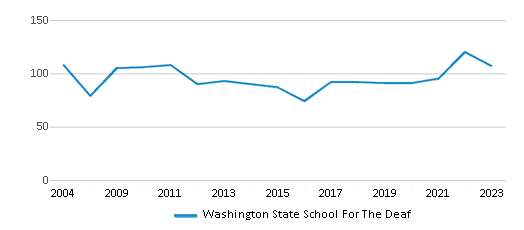
Gender %
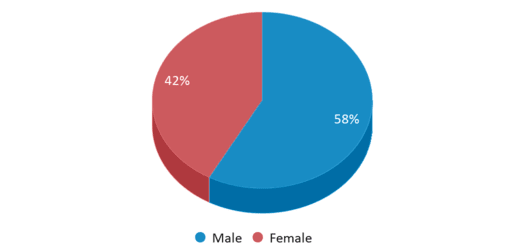
Total Classroom Teachers
n/a
Students by Grade
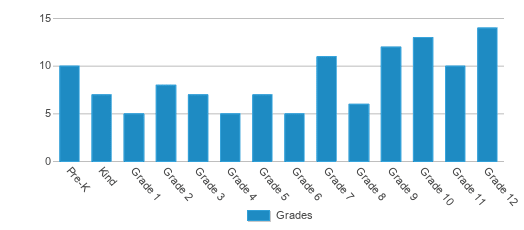
School Rankings
Washington State School For The Deaf ranks within the bottom 50% of all 2,113 schools in Washington (based off of combined math and reading proficiency testing data).
The diversity score of Washington State School For The Deaf is 0.69, which is equal to the diversity score at state average of 0.69. The school's diversity has stayed relatively flat over five school years.
Overall Testing Rank
#2099 out of 2113 schools
(Bottom 50%)
(Bottom 50%)
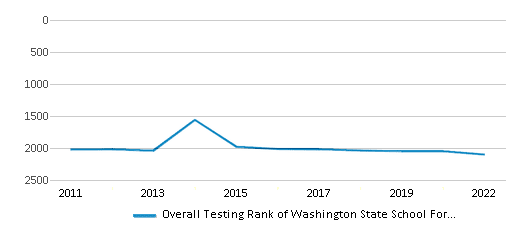
Math Test Scores (% Proficient)
≤10%
40%
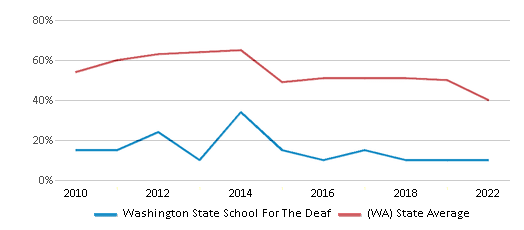
Reading/Language Arts Test Scores (% Proficient)
≤10%
53%
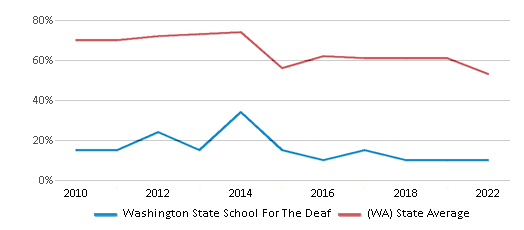
Science Test Scores (% Proficient)
≤20%
49%
Student : Teacher Ratio
n/a
16:1
American Indian
3%
1%
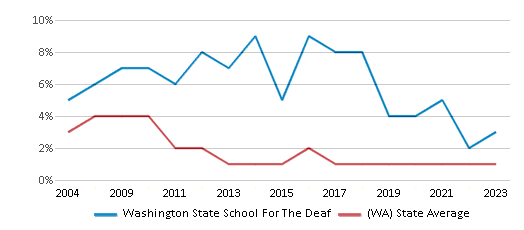
Asian
13%
9%
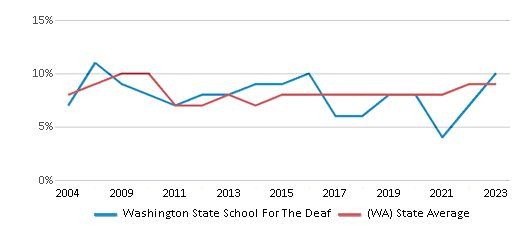
Hispanic
26%
26%
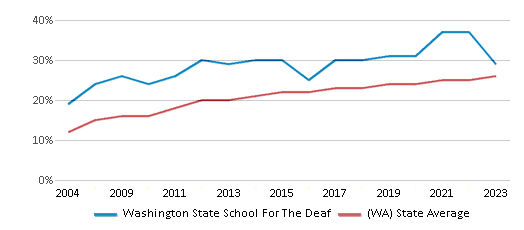
Black
5%
5%
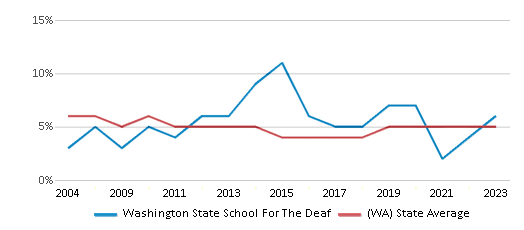
White
48%
48%
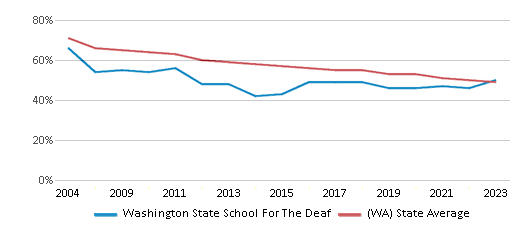
Hawaiian
3%
2%
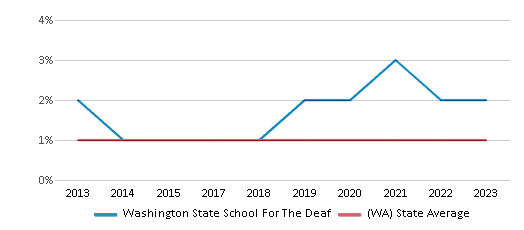
Two or more races
2%
9%
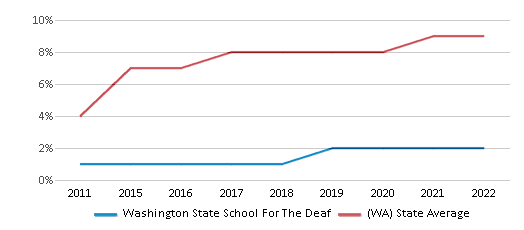
All Ethnic Groups
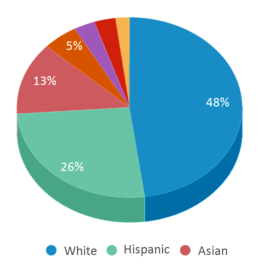
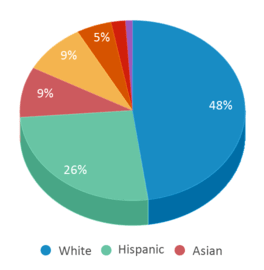
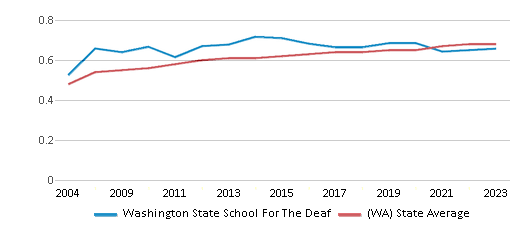
Graduation Rate
60-79%
84%
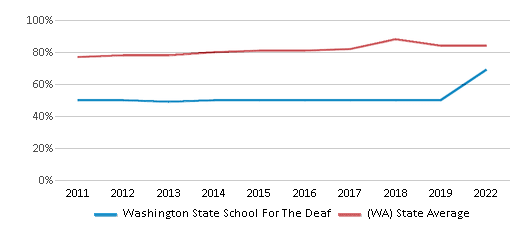
Participates in the National School Lunch Program (NSLP)
Yes
Eligible for Free Lunch
64%
49%
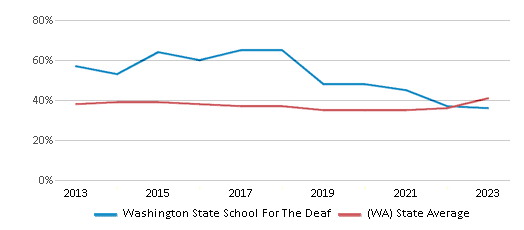
Eligible for Reduced Lunch
26%
8%
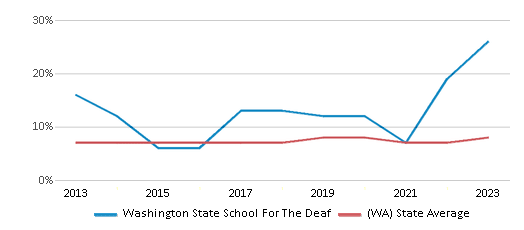
School Statewide Testing
School District Name
Source: National Center for Education Statistics (NCES), WA Dept. of Education
Profile last updated: 02/09/2025
Frequently Asked Questions
What is Washington State School For The Deaf's ranking?
Washington State School For The Deaf is ranked #2099 out of 2,113 schools, which ranks it among the bottom 50% of public schools in Washington.
What percent of students have achieved state testing proficiency in math and reading?
≤10% of students have achieved math proficiency (compared to the 40% WA state average), while ≤10% of students have achieved reading proficiency (compared to the 53% WA state average).
What is the graduation rate of Washington State School For The Deaf?
The graduation rate of Washington State School For The Deaf is 60-79%, which is lower than the Washington state average of 84%.
How many students attend Washington State School For The Deaf?
120 students attend Washington State School For The Deaf.
What is the racial composition of the student body?
48% of Washington State School For The Deaf students are White, 26% of students are Hispanic, 13% of students are Asian, 5% of students are Black, 3% of students are American Indian, 3% of students are Hawaiian, and 2% of students are Two or more races.
What grades does Washington State School For The Deaf offer ?
Washington State School For The Deaf offers enrollment in grades Prekindergarten-12
What school district is Washington State School For The Deaf part of?
Washington State School For The Deaf is part of Washington Center For Deaf And Hard Of Hearing Youth School District.
In what neighborhood is Washington State School For The Deaf located?
Washington State School For The Deaf is located in the Edgewood Park neighborhood of Vancouver, WA. There are 1 other public schools located in Edgewood Park.
School Reviews
5 10/11/2010
This is a school I went to for three years, their living facilitys are awsome, programs are wonderful, they have SLC (Student Life Counsilers). They try to get ideas from all students for programs. Classes are small which means more one on one with teachers. There are all sorts of handicap people with hearing problems and they are all helped and given things to help them. The teachers are for the most part wonderful but they can be harsh for those who like to fool around which is awsome. Although right now WSD is in need of serious help, The state of Washington is Cutting their budget big, which will result in closure of all their programs. The state is leave all public school budget alone. Even the deaf deserve the right to acidemic-programs. If you can help spread the word that this is unacceptable and help us fight to keep our programs at WSD, we will be greatful! Anyone looking to go to this school, I give this School a RATING OF 100!
Review Washington State School For The Deaf. Reviews should be a few sentences in length. Please include any comments on:
- Quality of academic programs, teachers, and facilities
- Availability of music, art, sports and other extracurricular activities
Recent Articles

What Is A Charter School?
Explore the world of charter schools in this comprehensive guide. Learn about their history, how they operate, and the pros and cons of this educational innovation. Discover key facts about charter schools, including admission policies, demographics, and funding, as well as what to look for when considering a charter school for your child.

10 Reasons Why High School Sports Benefit Students
Discover the 10 compelling reasons why high school sports are beneficial for students. This comprehensive article explores how athletics enhance academic performance, foster personal growth, and develop crucial life skills. From improved fitness and time management to leadership development and community representation, learn why participating in high school sports can be a game-changer for students' overall success and well-being.

February 05, 2025
Understanding the U.S. Department of Education: Structure, Impact, and EvolutionWe explore how the Department of Education shapes American education, from its cabinet-level leadership to its impact on millions of students, written for general audiences seeking clarity on this vital institution.





